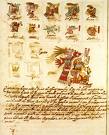
[This is taken from John D. Baldwin's Ancient America, originally published in 1871.]
In the “Actes de la Société Philologique,” Paris, for March, 1870, Mons. H. de Charencey gives some particulars of his attempt to decipher “fragments” of one or two very brief inscriptions on the bas-relief of the cross at Palenque. I know nothing of his qualifications for this work, but he appears to have studied the characters of the Maya alphabet preserved and explained by Landa. It is seen, however, that his attempt to decipher the inscriptions is a complete failure. In fact, he professes to have done no more than reproduce two or three words in Roman characters. He gives us Hunab-ku, Eznab, and Kukulcan as words found on the cross. Eznab is supposed to be the name of a month, or of a day of the week, and the others names of divinities. He finds that the characters of the inscriptions are not in all respects identical with those found in Landa, and that Landa’s list, especially when tested by the inscriptions, is incomplete. There is not absolute certainty in regard to the name Kukulcan; nevertheless, M. de Charencey makes this speculative use of it:
“The presence of the name ‘Kukulcan’ on the bas-relief of the cross is important in a historical point of view. The name of this demigod, which signifies ‘the serpent with the quetzal plumes,’ is the Maya form of the Mexican name ‘Quetzalcohuatl,’ which has precisely the same meaning. But we know that the name and worship of this god were brought to the high plateaus of Central America toward the ninth century of our era, consequently the bas-relief in question can not be more ancient.”
This assumes that the worship of Kukulcan was never heard of by the Mayas until the Aztecs arrived in Mexico, an assumption for which there is no warrant, and which proceeds in utter disregard of facts. It was the Aztecs who had never heard of Kukulcan, or, at least, had not adopted his worship, previous to this time. The Aztecs, when they settled in Anahuac, did not impart new ideas, religion, or culture to any body; on the contrary, they received much from the civilization of their new neighbors, which was more advanced than their own. It is very certain that neither the Mayas nor the Quichés borrowed any thing from them.
We need not go back so far as the ninth century to find the time when the Aztecs adopted, or at least organized in Mexico, the worship of Kukulcan, whose name they transformed into Quetzalcohuatl. His worship did not begin with them; they did not introduce it; they found it in the country as a very ancient worship, and adopted their form of it from the people who yielded to their sway.
If M. de Charencey will inquire with a little more care, he will discover that Kukulcan was one of the very oldest personages in Central American mythology, as Con was one of the oldest in that of Peru. Kukulcan, sometimes as Zamnà, was associated with almost every thing in civilization. He introduced the beginnings of civilized life, invented the art of writing, and was to the Central Americans not wholly unlike what Thoth was to the Egyptians, and Tautus, or Taut, to the Phœnicians. If the bas-relief of the cross at Palenque were half as old as his worship in Central America, it would be far more ancient than any one has supposed.
Copyright © D. J. McAdam· All Rights Reserved